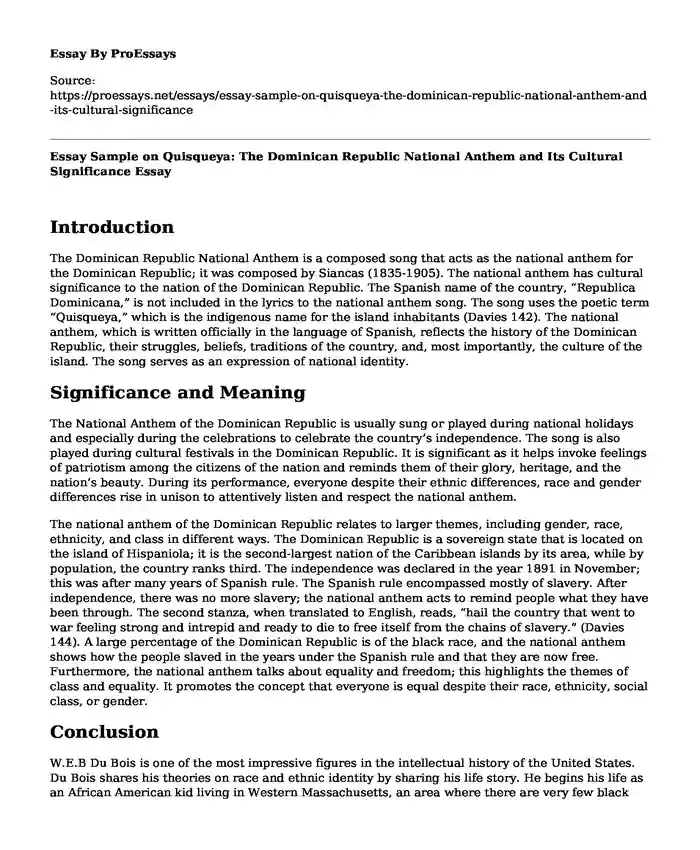Introduction
The Dominican Republic National Anthem is a composed song that acts as the national anthem for the Dominican Republic; it was composed by Siancas (1835-1905). The national anthem has cultural significance to the nation of the Dominican Republic. The Spanish name of the country, “Republica Dominicana,” is not included in the lyrics to the national anthem song. The song uses the poetic term “Quisqueya,” which is the indigenous name for the island inhabitants (Davies 142). The national anthem, which is written officially in the language of Spanish, reflects the history of the Dominican Republic, their struggles, beliefs, traditions of the country, and, most importantly, the culture of the island. The song serves as an expression of national identity.
Significance and Meaning
The National Anthem of the Dominican Republic is usually sung or played during national holidays and especially during the celebrations to celebrate the country’s independence. The song is also played during cultural festivals in the Dominican Republic. It is significant as it helps invoke feelings of patriotism among the citizens of the nation and reminds them of their glory, heritage, and the nation’s beauty. During its performance, everyone despite their ethnic differences, race and gender differences rise in unison to attentively listen and respect the national anthem.
The national anthem of the Dominican Republic relates to larger themes, including gender, race, ethnicity, and class in different ways. The Dominican Republic is a sovereign state that is located on the island of Hispaniola; it is the second-largest nation of the Caribbean islands by its area, while by population, the country ranks third. The independence was declared in the year 1891 in November; this was after many years of Spanish rule. The Spanish rule encompassed mostly of slavery. After independence, there was no more slavery; the national anthem acts to remind people what they have been through. The second stanza, when translated to English, reads, “hail the country that went to war feeling strong and intrepid and ready to die to free itself from the chains of slavery.” (Davies 144). A large percentage of the Dominican Republic is of the black race, and the national anthem shows how the people slaved in the years under the Spanish rule and that they are now free. Furthermore, the national anthem talks about equality and freedom; this highlights the themes of class and equality. It promotes the concept that everyone is equal despite their race, ethnicity, social class, or gender.
Conclusion
W.E.B Du Bois is one of the most impressive figures in the intellectual history of the United States. Du Bois shares his theories on race and ethnic identity by sharing his life story. He begins his life as an African American kid living in Western Massachusetts, an area where there are very few black people; he notices that he is different, and explains the struggles he goes through. He goes to school in German, and this is where he realizes that race can still come as a secondary thing; in German, he is viewed as a normal student pursuing his studies. He says that while in German, he becomes more human. One of Du Bois’s interesting remarks is where he defines the term “Negro” as “a person who must ride Jim Crow in Georgia.” (Du Bois, 19) The line has many meanings, but what it means is that for a black man to be free, he must get rid of Jim Crow, a reference for a white man. This links to the national anthem of Dominica Republic. The lines in the national anthem constantly talk about slavery and how the people of the nation went to war and won for them to be free. They had to get rid of the Spanish people to be free.
Work Cited
Davis, Martha Ellen. “The Dominican Republic.” The Garland Handbook of Latin American Music. Routledge, 2007. 167-186.
Du Bois, William Edward Burghardt. “The souls of black folk.” Oxford University Press, 2008.
Cite this page
Essay Sample on Quisqueya: The Dominican Republic National Anthem and Its Cultural Significance. (2023, Oct 15). Retrieved from https://proessays.net/essays/essay-sample-on-quisqueya-the-dominican-republic-national-anthem-and-its-cultural-significance
If you are the original author of this essay and no longer wish to have it published on the ProEssays website, please click below to request its removal:
- Social Policy Issue: Food Stamps Essay
- Issues in Cultural Tourism Studies: Developing Museums for Visitor Involvement Essay
- Was John Brown a Terrorist? Essay Example
- Disproportionate Minority Contact Policy Essay Example
- Geo-Blocking: Restricting Access to Online Services & Products - Essay Sample
- Kelly's Struggles With Cultural Diversity in Japan - Essay Sample
- Essay Example on Gender Inequality in Nursing: A Real Challenge







